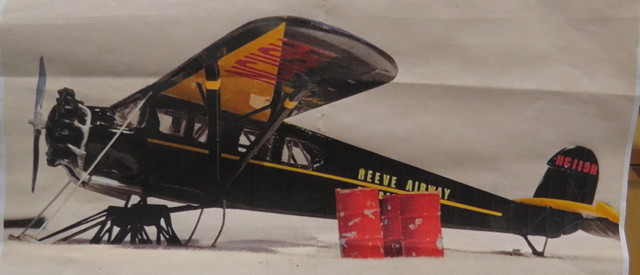1929 Fairchild 71 NC119H

The FC-2W, later known as the Model 71, was built in the United States between 1928 and 1930.
A series of related designs beginning with the Fairchild FC-1 and continuing to the Fairchild 71 were designed for aerial photography as a result of dissatisfaction towards available aircraft which were incapable of flying steadily enough at a sufficient altitude.
In 1935, Fairchild was hired by the US government to do aerial photograph surveys of the United States to track soil erosion and its effects.
Their performance and carrying ability led to them becoming one of the most popular bushplanes of the era.
A Fairchild 71 monoplane, the Virginia, was taken as one of three aircraft by (Wikipedia) Richard E. Byrd on his 1928–1929 expedition to the South Pole. It was used for test flights and reconnaissance. (Wikipedia) Norman Vaughan drove sled dogs on the expedition.
On August 13, 1930, Matt Nieminen and his mechanic Cecil Higgins, made the first flight over Denali in a Fairchild 71.
The Alaska Aviation Museum has acquired one of the most important historical Alaskan aircraft to find its way into the collection. The 1929 Fairchild 71 was one of the most important and prolific Alaskan aircraft of the 1930’s. The aircraft type was used by Alaskan Airways, Wien Alaska, Pacific Alaska Airways, Marine Airways and Reeve Airways among others.
The Fairchild 71 was first introduced to Alaskan skies by Canadian pilot Pat Reid who brought several examples into the territory to participate in the Siberian search for Ben Eielson in January 1930. Pacific Alaska Airways operated the largest fleet utilizing 13 examples of the Fairchild. Several PAA a/c were in service in Southeastern Alaska in the mid 1930s including the museum’s example NC119H. PAA pulled up stakes in Juneau in 1936 when its operation proved unprofitable. NC119H was sold to the famous pioneer Alex Holden dba Marine Airways. When Holden merged his air service with Shell Simmons’ Alaska Air Transport in 1939, the new company became known as Alaska Coastal Airlines. (ACA merged with Alaska Airlines in 1967-68.) NC119H became surplus and was sold to Bob Reeve who flew the plane for many years including flights to the Aleutians.
In 1967 Reeve, along with Jack Peck, Jack Jeffords and others, founded the original Transportation Museum for the Alaska Centennial in Anchorage.
The museum was populated by many of the aircraft preserved in the state today. One of the aircraft was NC119H which was donated by the Reeve family to add to the collection. In 1973 the museum caught fire destroying a number of important artifacts and aircraft. Fortunately NC119H survived and became the property of the Transportation Museum of Alaska; first based in Palmer and then Wasilla.
The Alaska Aviation Museum is indeed fortunate to have acquired this extremely rare historical aircraft at a very modest price. The acquisition truly enriches the museum’s collection immeasurably. The Fairchild 71 is a very scarce survivor with probably less than a half dozen still in existence. Not only was the Fairchild 71 an important Golden Age pioneer aircraft in Alaska, the type played a big role in national and international aviation history. Of special note are the operations in Canada and in the Antarctic expeditions of the 1930’s.
Bob Reeve's Fairchild 71 is being restored in the restoration hangar.
